
Pork Menu: 1 2 3 4 5 Next>>
Pork As Food During the Golden Age of Piracy, Page 1
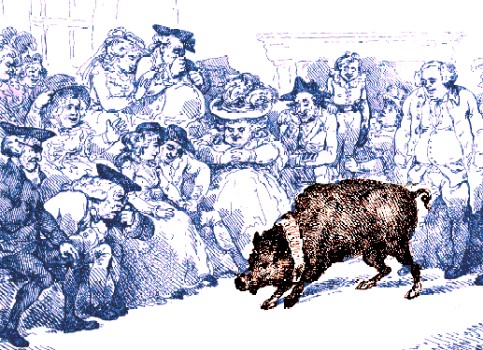
The Wonderful Pig by Thomas Rowlandson (1775)
"The [pirates] loot amounted to thirty-seven barrels of pork, three of beef and a good supply of pease, Indian corn, butter and cheese. Having at last obtained the provisions so necessary for a southern voyage [from Boston], Captain [Thomas] Pound anchored in Tarpaulin Cove while the rigging was overhauled and everything made shipshape for the intended voyage to 'Corazo' – Curacao, the Dutch colony near the South American Coast." (George Francis Dow and John Henry Edmonds, The Pirates of the New England Coast 1630-1730, p. 63)
You may notice that a large part of the supplies that pirate captain Pound took were barrels of salt pork. Pork and pigs were an important part of sea life during the golden age of piracy.
Pork as Food
"In three months more I was able to ride down to the Bridge, where finding a Ship bound for England, I agreed for my passage and dyet by the way; and (as the manner of all Masters of ships is) he made me large promises of plentiful provisions aboard, as Beefe, Porke, Pease, Fish, Oyle, Bisket, Beere, and some Wine." (Richard Ligon, A True and Exact History of the Island of Barbadoes, p. 119)
Pork held a place during this time as an important and prized food store. When discussing what sort of food would be most practical at sea, Nathaniel Boteler explained that "the difficulty [in eating other foods] consisteth in that

Woodes Rogers by William Hogarth (1729)
our common seamen are so besotted in their beef and pork that they had rather adventure on all the calentures [delirious fevers caused by tropical heat] and scurvies in the world than to be weaned from their customary diet, or lose the
least bit of it. So that is may be doubted that any alteration this way would put them into a running away from the services of State as much as anything else whatsoever."1
A story from Commodore Woodes Rogers multi-year privateering voyage in the early 18th century highlights the high regard the men had for pork. Rogers reported on January 28 of 1710 that "the Steward missing some Pieces of Pork, we immediately search'd, and found the Thieves , one of 'em had been guilty before, and forgiven, on promise of Amendment, but was punish'd now…I order'd 'em to the Main Jeers [a assembly of tackles used to hoist or lower the lower spars of a ship], and every Man of the Watch to give 'em a Blow with a Cat of Nine-tails, and their Mess-mates being privy to the Theft, were put in Irons."2
We begin with a look at the types of pork that were eaten shipboard. Next we'll examine various ways in which pork was eaten on a ship as well as some of the problems with keeping the pork edible. We end the discussion of pork as food with a discussion about how fresh pork could be brought and kept aboard a ship.
1 Nathaniel Boteler [Butler], Boteler's Dialogues, p. 64; 2 Woodes Rogers, A Cruising Voyage Round the World, p. 61
Types of Pork
In the 1797 cookbook The Accomplished Housekeeper, and Universal Cook, the author discusses regular hogs and bacon hogs as two separate types.1 Here, 'bacon' does not refer to the strips of cured pork we think of so readily today; it refers to the type of hog - a leaner
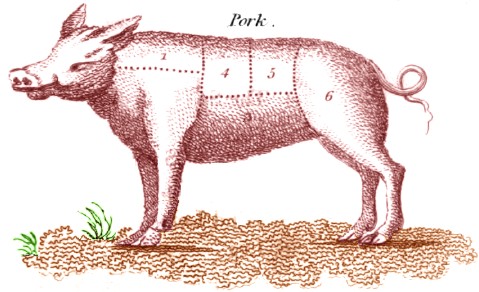
Cuts of Pork from A New System of Domestic Cookery, by Maria Eliza Rundell (1808)
animal which had been raised specifically for meat.
In the book, the author explains how a bacon hog is to be cut up, "making hams, bacon, and pickled pork. Here you have fine spare-ribs, chines (the area across the backbone between the shoulder blades), and griskins (lean cut from the loin), and fat for hog's-lard. The liver and crow are much admired fried with bacon; the feet and ears are both equally good soused [pickled in brine and vinegar]."2
Since the three primary types of meat identified in this book are salted (pickled) pork, ham and bacon and each are mentioned in period sea journals, we will discuss them in more detail.
1,2 T. Williams, The Accomplished Housekeeper, and Universal Cook, p. 3
Types of Pork at Sea: Salted
"In the Month of July, these Adventurers [pirate Stede Bonnet's crew] came off the Capes, and meeting with a Pink with a Stock of Provisions on Board, which they happened to be in Want of, they took out of her ten or twelve Barrels of Pork, and about 400 Weight of Bread; but because they would not have this set down to the Account of Pyracy, they gave them eight or tea Casks of Rice, and an old Cable, in lieu thereof." (Captain Charles Johnson, The General History of the Pyrates, 3rd edition, p. 94-5)
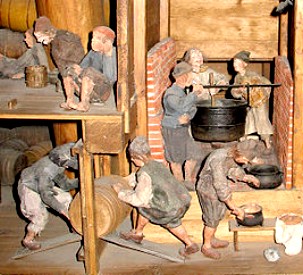
Photo: Peter Isotalo
A Barrel of Meat Being Moved By the Galley. From a
Model of the Swedish Warship Vasa in the Vasa Museum
Salted pork was widely used on ships on long sea voyages. The British Naval diet included "a gallon of beer and a pound of biscuit daily, on Sundays and Tuesdays two pounds of salt beef; on Mondays and Thursdays one pound of salt pork and one pint of peas, or if pork was lacking one pound and a half of beef instead; on Wednesdays, Fridays and Saturdays one-eighth of a pound of butter and one quarter of a pound of cheese."1
Salted pork was an important foodstuff on a ship. On October 9th, 1709, privateer Woodes Rogers reported that his store of salt beef and pork "held to the Gallapagos, and we have fed on the Turtle we got there ever since, excepting these two last Days. This accidental Stock of fresh Food has been some Refreshment to our Men, and prolongs our Stock of European Provisions."2
On land, salting of pork was usually performed in the fall in preparation for storage during the cold winter months. In The Accomplished Housekeeper, and Universal Cook, author T. Williams explains, "Pork comes in season at Bartholomew-tide (August 24th), and holds good till about Lady-day (March 25th)."3 Salting was one of the only ways meat could be preserved at this time. The meat is preserved because the salt solution draws water out of the cells of the meat through osmosis. "Concentrations of salt up to 20% are required to kill most species of unwanted bacteria. Smoking, often used in the process of curing meat, adds chemicals to the surface of meat that reduce the concentration of salt required."4

Artist: Thomas Hudon
Admiral Sir Charles Knowles (1790)
JAS Townsend and Company explains one process of preparing salt pork in a well-detailed video, which can be viewed here. Closer to period, we have BRN Admiral Charles Knowles recipe for salting ox, which varies a bit from the Townsend recipe. Knowles advised that the meat be "skinned and cut up into pieces fit for use, as quick as possible, and salted while the meat be hot" with saltpeter (potassium nitrate).5 JAS Townsend is a bit more specific, recommending 1" thick pieces of meat.6 Knowles recommends sprinkling the meat with saltpeter, "at the rate of about two ounces per pound. Then lay the pieces on shelving boards to drain for twenty-four hours longer." He then says to turn the pieces over and repeat the process. "By this time, the salt will be all melted, and have penetrated the meat.... Each piece must then be wiped dry with clean course cloths"7.
Regular salt was then heated in an oven and mixed with half as much brown sugar which was used to rub each piece of meat.8 They were then packed into the barrel, "allowing about half a pound of the salt and sugar to each pound of meat."9 With regard to salting pork, Knowles explains, "a larger quantity of salt, and less sugar [should be used, although] the preservation of both [ox and pork] depends equally upon the meat being hot when first salted."10
In 1725 cookbook, Robert Smith gave a fairly intricate recipe for salting pork.
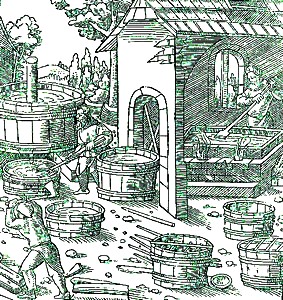
Artists: Georgius Agricola & Johann Becher
Making Salt Peter (1580)
[To make brine use] three of four Gallons of Water, and put to it four Pound of Bay-Salt [salt left by evaporated sea water], four Pounds of White Salt [rock salt obtained by evaporation, added to sea water and then evaporated again], a Pound of Petre-Salt [niter in its natural state], a Quarter of a Pound of Salt-Peter [refined niter], two Ounces of Prunellla-Salt [niter fused and formed into little balls], and a Pound of brown Sugar; let it boil a quarter of an Hour, scum it well, when 'tis cold, sever it from the Bottom of the Vessel you keep it in. Let Hams lie in Pickle four or five Weeks...dry them in a Stove or Wood-Chimney; the latter I like the best.11
Knowles suggests that salt meat in casks "will keep good several years, and eat very well."12 Much of his naval career was spent in the West Indies, so he would seem to be a knowledgable source. While not giving it quite the same shelf life, Woodes Rogers' account, cited previously, refers to keep their 'European Provisions' for more than a year after they left England.13 Knowles explained that to keep the meat preserved, "the seldomer it is exposed to air the better."14
Salt pork could also be purchased during a voyage. Sailor Alexander Hamilton reported that in Bengkalis [in Indonesia, on the Sumatra Coast], the natives would annually chase and capture wild pork and cut it into small pieces. "After it has lien three or four Days in Salt, they wash the Pork, and hang it in Smoke, and then put it into Casks, which they have ready for their Purpose, with some dry Salt, and sell it by the Cask to the best Bidder."15
1 Karl Vogel, "Medicine at Sea in the Days of Sail," Milestones in Medicine, Edited by James Alexander Miller, New York, 1938; 2 Woodes Rogers, A Cruising Voyage Round the World, p. 144-5;3 T. Williams, The Accomplished Housekeeper, and Universal Cook, p. 3; 4 Salt-cured meat, Wikipedia, gathered 4/3/14; 5 John Farley, The London Art of Cooker, and Housekeeper's Complete Assistant, p. 289; 6 Preparing Salt Pork - 18th Century Cooking with Jas Townsend and Son S1E5, gathered 4/3/14; 7 Farley, p. 289; 8 Farley, p. 289-90; 9,10,11 Farley, p. 290; 11 Robert Smith, Court cookery: or, The compleat English cook, p. 93-4; 12 Rogers, p. 144; 13,14 Farley, p. 290; 15 Alexander Hamilton, British sea-captain Alexander Hamilton's A new account of the East Indies, 17th-18th century, p. 416
Types of Pork at Sea: Ham
Ham during the golden age of the pirates wasn't quite what we think of today, although the essence of a modern ham existed. The Oxford English Dictionary explains that ham is the "Meat from the upper part of a pig’s leg salted and dried or smoked"1. This is accurate to period as we saw in the previous section - pork was prepared for sea voyages by being salted and sometimes smoked. However, modern ham is cured in brine that contains a large amount of sugar, which give it the flavor which we associate with the meat.2 While sugar may have been used to cure pork during period, it would likely have been far less than the ham we buy today.
Ham is often thought to be the province of officers during this period.
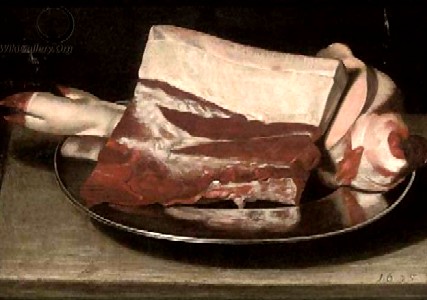
Photo: Sebastian Stoskopff
A Leg of Pork on a Pewter Plate on a Table (mid 17th century)
Certain cuts of meat were definitely recognized as being better than others at this time, as is revealed by Edward Barlow's complaint in December 1668 that "we had nothing to our Christmas dinner but a bit of old rusty salt beef, which had lain in pickle eighteen or twenty months, and a piece of it for three men, about three-quarters of a pound, which was picked out of all the rest, for the officers having the first choice always, nothing was left for the poor men but the surloin next to the horns, and they have Hobson's choice ['that or noe']"3
However, the only period English sailor's journals that mention ham specifically by name is Woodes Rogers' book.4 After Roger's ships took a Swedish vessel and failed to find contraband on board so that they could declare it a privateering prize, Rogers explains that they were "not willing to hinder time to carry her [the Swedish ship] into any Harbour to examine her farther, we let her go without the least Embezelment. The Master gave me two hams, and some rufft dry'd Beer, and I gave him a dozen Bottles of Red-streak Cyder."5 This exchange hints that ham was at least considered worthy of being given as a gift.
It is notable that ham is not mentioned more often during the period, given that most of the journals from this time were written by officers, who would have sought the choicer cuts of meat. The term 'ham', referring to the meat of a hog's hind leg, dates at least as far back as the 1630s.6 However, the 
Père Jean-Baptiste Labat, Frontispiece
Nouveau Voyage aux Isles de
l'Amerique, Vol.1 (1722)
English word 'gammon', an Old French word referring to the same thing, dates back two hundred years before.7 Barlow mentions that when his ship arrived in Batavia Road in 1688, they sold the
Dutch ships they found there "some few commodities, as beer, and wine, and red herrings and white, and cheese, and gammons, backs and suchlike."8 This again hints at the desirability of ham or gammon as worthy of purchase by other ships.
The one period account that does mention ham in specific terms is French priest Jean-Baptiste Labat's memoirs. Labat explains that the merchants and parson in Grenada gave him "a present of some chickens, two pies, two cured hams, preserves, fruit, Madeira, and much beer and cider."9
During another of Labat's voyages, he noted that ham was a part of breakfast on 'Sundays and Fête-days.' "This meal, as a rule, consisted of a ham or a Pâté, with a ragout or fricassee, new bread, butter, cheese, and above all very excellent wine."10 On these days, for desert after dinner, "we had cheese, hams, stewed fruits and nuts."11 This is notable; Labat would have dined with the officers of the ship and food on the feast days would likely have been better than normal. So ham was clearly a cut above.
1 Ham (second definition), Oxford English Dictionary Online, gathered 4/1/14; 2 Bacon, Wikipedia, gathered 4/6/14; 3 Edward Barlow, Barlow’s Journal of his Life at Sea in King’s Ships, East and West Indiamen & Other Merchantman From 1659 to 1703, p. 160-1; 4 Thanks to Cobber Adams for finding this reference; 5 Woodes Rogers, A Cruising Voyage Round the World, p. 14; 6 ham, Online Etymology Dictionary, gathered 3/27/14; 7 gammon, Online Etymology Dictionary, gathered 4/6/14 - Thanks to Jennie Gist for pointing this out; 8 Barlow, p. 390; 9,10,11 Pere Jean-Baptiste Labat, The Memoirs of Pére Labat 1693-1705, p. 130
Bacon
If understanding what the term 'ham' meant during the golden age of pirates is a challenge, the word 'bacon' is doubly so. We've already discussed the fact that certain kinds of hogs raised specifically for their meat were called "bacon hogs"1. 'Bacun' in Old French was used to refer to meat from the back of the hog beginning in the 14th century. By the 16th century, Middle English had expanded the meaning in the word "bacoun" which
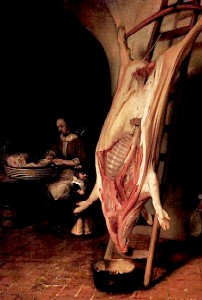
Artist: Barent Fabritius
The Slaughtered Pig (1656)
referred to any cured (salted) pork, not just the back meat.2 Today, what Americans think of as 'bacon', which is found neatly vacuum-sealed in grocery stores coolers, comes from the belly.3 Thus bacon began on the back of the hog, expanded to encompass the whole hog and finally made the trip to the stomach where there is more fat.
Similar to the period, today's bacon is cured by salting in a brine solution - usually sodium nitrate, although it may also be cured in potassium nitrate (saltpeter) as was done to all the pork going on ships during the golden age of piracy. Some bacon curing even includes using brown sugar in the brine - just like Knowle's recipe. There the similarities end, however. Other elements such as sodium ascorbate or erythorbate may be added to speed up the curing process and stabilize coloring. Sodium polyphosphates may also be added to make bacon easier to slice and cook.
However, identifying bacon so precisely is mostly an academic undertaking with regard to period seamen. All of their pork would have been retrieved from the cask or barrel and cooked in the same way - often in soups or stews - regardless of the cuts of meat. The exception here would be what was fed to the officers, as was discussed in the previous section.
Bacon is not mentioned as a specific cut of meat in any period sea memoir under consideration. Surgeon William Clowes, writing in the late 16th century does use the term in a disparaging fashion in reference to a pair of 'seafaring men', explaining that "their bacon was resty [rusty - discolored and rancid], their fish, butter and cheese wonderful bad, and so consequently all the rest of their victuals."4 Based on the time period and the context, he was referring to salt pork in general and not the specific cut of the hog. What we call bacon today would have been foreign to a golden age of piracy sailor.
1 T. Williams, The Accomplished Housekeeper, and Universal Cook, p. 3; 2 Karen Hochman, Bacon History: Bringing Home the Bacon in 9000 BC, The Nibble.com, posted August 23, 2011, gathered 4/2/14; 3 Bacon, Wikipedia, gathered 4/6/14; 2 William Clowes, Selected Writings of William Clowes, p. 119

